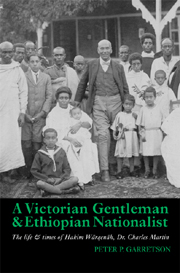 A Victorian Gentleman and Ethiopian Nationalist
A Victorian Gentleman and Ethiopian Nationalist Book contents
- Frontmatter
- Contents
- List of Illustrations
- Transliteration
- Note on the Ethiopian Calendar
- Glossary
- Acknowledgements
- Map 1 Ethiopia 1900–1950
- Map 2 Burma 1898–1919
- Introduction
- 1 Youth & education
- 2 Return to Ethiopia (1896–1901)
- 3 Campaigning in the Ogaden & return to Burma (1901–1907)
- 4 Transitions in life
- 5 A man of substance in Ethiopia & Burma
- 6 Return of a progressive to Addis Ababa (1919–1924)
- 7 An increased pace of modernization (1924–1930)
- 8 International diplomacy, education & recruitment
- 9 Governor of a model province, Chärchär (1930–1935)
- 10 Ethiopian ambassador to the Court of St. James (1935–1936)
- 11 London & India
- 12 Ethiopia
- Conclusion
- Bibliography
- Index
1 - Youth & education
Ethiopia, India & Burma (1865–1896)
Published online by Cambridge University Press: 05 April 2013
- Frontmatter
- Contents
- List of Illustrations
- Transliteration
- Note on the Ethiopian Calendar
- Glossary
- Acknowledgements
- Map 1 Ethiopia 1900–1950
- Map 2 Burma 1898–1919
- Introduction
- 1 Youth & education
- 2 Return to Ethiopia (1896–1901)
- 3 Campaigning in the Ogaden & return to Burma (1901–1907)
- 4 Transitions in life
- 5 A man of substance in Ethiopia & Burma
- 6 Return of a progressive to Addis Ababa (1919–1924)
- 7 An increased pace of modernization (1924–1930)
- 8 International diplomacy, education & recruitment
- 9 Governor of a model province, Chärchär (1930–1935)
- 10 Ethiopian ambassador to the Court of St. James (1935–1936)
- 11 London & India
- 12 Ethiopia
- Conclusion
- Bibliography
- Index
Summary
Ethiopia
Wärqenäh Eshäté was born in Gondär, Ethiopia, on October 22, 1865 into an important Gondarine family, descended from Emperor Fasilidas (1632-1667). Fasilidas had founded Gondär and Wärqenäh's immediate family remained there until the reign of Emperor Téwodros (1855–1868). His uncle, Aggedäw, was the Näggadras of Gondär (until the late nineteenth century) and the future Näggadras of Addis Ababa, an important and lucrative municipal and national position (literally, head of merchants), commensurate with his family's influence in Ethiopia's capital from the seventeenth to the mid-nineteenth century. Many members of his family were important merchants. Later these ties to important northern families increased his influence at Emperor Menilek's court when he returned to Ethiopia in 1899.
The decline of the Ethiopian monarchy in the late eighteenth century through to the middle of the nineteenth century led to the increased weakness of the emperor and the central government, while power shifted to the provinces and the regional nobles. The period has aptly been called ‘the era of the Princes.’ Most historians give credit to Emperor Téwodros for beginning the revival of central authority and at least the rhetoric of supporting modernization. Later in life Wärqenäh would contribute significantly to both. Wärqenäh's autobiography gives some useful background in explaining these years.
- Type
- Chapter
- Information
- A Victorian Gentleman and Ethiopian NationalistThe Life and Times of Hakim Wärqenäh, Dr. Charles Martin, pp. 7 - 22Publisher: Boydell & BrewerPrint publication year: 2012


